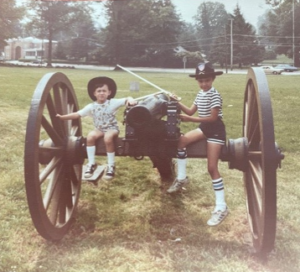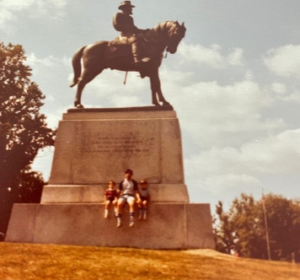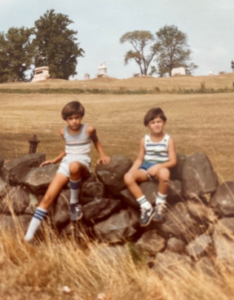 The conversations at my family dinner table usually center around daily activities: what the kids did at school, which beach are we going to this weekend, whose pool can we finagle an invitation to – normal things. Recently, while my kids and I visited with my older brother, we showed them some pictures of the two of us growing up in the 1980s. They were particularly interested in the pictures seen at left (and below), of my brother and me at the battlefield in Gettysburg, Pennsylvania. Questions flew, such as: “Wow, dad, is that a real cannon?” “Does it still work?” and “Can we go there someday so I can sit on the cannon?”
The conversations at my family dinner table usually center around daily activities: what the kids did at school, which beach are we going to this weekend, whose pool can we finagle an invitation to – normal things. Recently, while my kids and I visited with my older brother, we showed them some pictures of the two of us growing up in the 1980s. They were particularly interested in the pictures seen at left (and below), of my brother and me at the battlefield in Gettysburg, Pennsylvania. Questions flew, such as: “Wow, dad, is that a real cannon?” “Does it still work?” and “Can we go there someday so I can sit on the cannon?”
We grew up in Harrisburg, Pennsylvania, and often visited the battlefield at Gettysburg throughout our early lives (until moving away after ten years). My children (aged 4 and 7 – too young to have been taught this in school yet) were blown away by some of the facts that my brother and I told them, including that family members fought against each other on the battlefield. After assuring them that neither my brother nor I would ever fight against each other (as we eyed one another across the table, sizing each other up for the post-dinner ping-pong battle that could potentially come to blows), we reminisced about the fact that we didn’t fully appreciate the battlefield and all it represented at such a young age.
 History books in school and some personal copies of Stephen Sears’ Gettysburg had taught us that “Gettysburg proved to be both the largest battle fought during the war and the costliest. The two armies between them lost more than 57,000 men….”[1]
History books in school and some personal copies of Stephen Sears’ Gettysburg had taught us that “Gettysburg proved to be both the largest battle fought during the war and the costliest. The two armies between them lost more than 57,000 men….”[1]
The fact that one military battle cost this many American lives is still jaw-dropping to this day. While today’s political and cultural climate could possibly hint at deeper unrest among Americans, our dinner table conversation that night centered around the immense hope that nothing like the Civil War would ever happen again. Amazingly, Tom Porter of Business Insider wrote on 1 July 2019 that “so many Civil War soldiers were killed at Gettysburg that they were still finding remains to bury in 1996.”[2]
 If I could give advice to anyone reading this, it would be to visit the Gettysburg battlefield, where the National Park Service keeps the Gettysburg National Military Park Museum and Visitor Center. Sit on one of the stone walls that still stand today, think about the huge number of Americans who fought on that vast field, think of the military strategy employed, and remember the terrible loss of life. My older bother and I recently walked down memory lane with my own children, and we hope that future generations will always remember that costly battle and the toll it took on so many families.
If I could give advice to anyone reading this, it would be to visit the Gettysburg battlefield, where the National Park Service keeps the Gettysburg National Military Park Museum and Visitor Center. Sit on one of the stone walls that still stand today, think about the huge number of Americans who fought on that vast field, think of the military strategy employed, and remember the terrible loss of life. My older bother and I recently walked down memory lane with my own children, and we hope that future generations will always remember that costly battle and the toll it took on so many families.
Notes
[1] Stephen W. Sears, Gettysburg (Boston and New York: Houghton Mifflin Company, 2003), xiv.
[2] Business Insider online at https://www.businessinsider.com/gettysburg-death-toll-so-high-bodies-still-found-1996-2019-6.
Share this:
About Andrew Krea
Andrew Krea holds a B.A. in English Literature from Brandeis University, in Waltham, Massachusetts, and a Master’s Degree in Library Science from Simmons College in Boston, Massachusetts. He has previously interned at the Massachusetts Historical Society. His areas of interest and expertise include New England research, specifically genealogies dating back to the inception of the Massachusetts Bay Colony, and researching and writing historical narratives of family genealogies.View all posts by Andrew Krea →